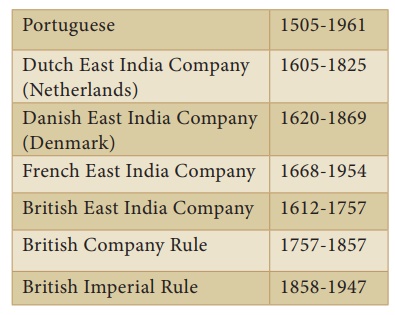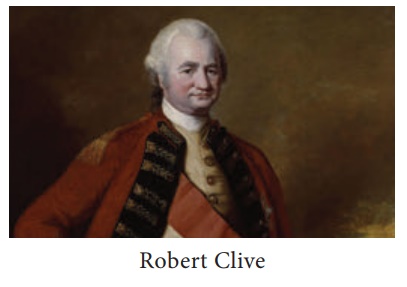History - Colonisation of India | 9th Social Science : History: Colonialism in Asia and Africa
Chapter: 9th Social Science : History: Colonialism in Asia and Africa
Colonisation of India
Colonisation of India
Towards the close of the 15th century, Portugal became the first
European power to establish a trade link with India. Rounding the Cape of Good
Hope Vasco da Gama arrived in Calicut in 1498. Soon other European powers
joined Portugal in establishing their presence in India. The European powers in
India since 16th century are given below:

In the rivalry among four major European powers – Portuguese,
Dutch, French and English – the English, after three Carnatic Wars, eliminated
the French by the end of the eighteenth century. The British conquered all the
regional powers, in particular the most potential challengers, the Mysore
Sultans and the Marathas, by defeating them in three Anglo-Mysore and three
Anglo- Maratha Wars. The conquest of the Gurkhas (1816), the Sindhis (1843) and
the Sikhs (1849) enabled them to emerge as a territorial power in India.
The Colonialisation of Indian Economy
We can divide the process of
the colonialisation of India into three phases
a.
Phase I Mercantilist Capitalism
b.
Phase II Industrial Capitalism
c.
Phase III Financial Capitalism
Colonialisation
of Indian Economy: Mercantilist Phase (Outright Plunder; 18th Century).
At the beginning of the 18th century the East India Company was
still a marginal force in India. It relied on concessions from Indian rulers
for its trading posts along the coast. But soon it managed to establish strong
ties with Indian merchants who sold their textiles and other goods from the
interior. Before it gained dominion in India the East India Company carried on
a very profitable business selling Indian-made cotton textiles and silks and
printed cloth. According to the Indian nationalist economist R.C. Dutt, weaving
was the national industry of the people and spinning was the pursuit of
millions of women. Indian textiles went to England and other parts of Europe,
to China and Japan and Burma and Arabia and Persia and parts of Africa. It was
during this period that the textile lobby in Lancashire and Birmingham
succeeded in making the Parliament enact a law prohibiting the import of Indian
textiles. Those who were found in possession of or dealing in Indian cotton
goods were fined 200 pounds. ![]()
Mercantilism: Mercantilism refers to a number of prevailing
economic theories applied by the state in its effort to attain wealth and
power. Spain in the sixteenth century was the richest and most powerful in the
world. Spain’s power and wealth were found in the treasure pouring into Spain
from its colonies. The more colonies a country had, the richer it would be. In
sum, European countries pursued Mercantilism as a kind of national economic
policy designed to maximize their trade, especially to maximize the
accumulation of gold and silver.
In the 1750s and the early 1760s, Robert Clive gained control of
the wealthiest part of the old Mughal Empire. The Company exacted concessions
such as exemption of Company goods from transit duties, which even Indian
merchants had to pay. After the Battle of Plassey (1757), the Company got 1.2
million pounds out of which Clive himself took 31,500 pounds besides a jagir
which provided an annual income of 27,000 pounds. After the Battle of Buxar
(1764), the Murshidabad treasury was looted. The Company acquired the Diwani
right in 1765 and became the revenue farmer of the Mughal Emperor.

The money looted and carried from India helped to finance the
Industrial Revolution in England. After the Industrial Revolution in England,
instead of protecting and encouraging industries in India, the East India
Company crushed every industry which came in conflict with British industry.
The ship-building industry collapsed. Metal workers could not sustain their
craft and the manufacture of glass and paper dwindled. India which had been the
“Lancashire of the Eastern World” began to lose its position when its cottage
industries had to compete with machine industry developed in England. Thrown
out of employment, the weavers and other artisans who lived in towns and cities
had to return to villages. The agricultural sector, which was already
over-crowded, had to support all these unemployed artisans.
Related Topics